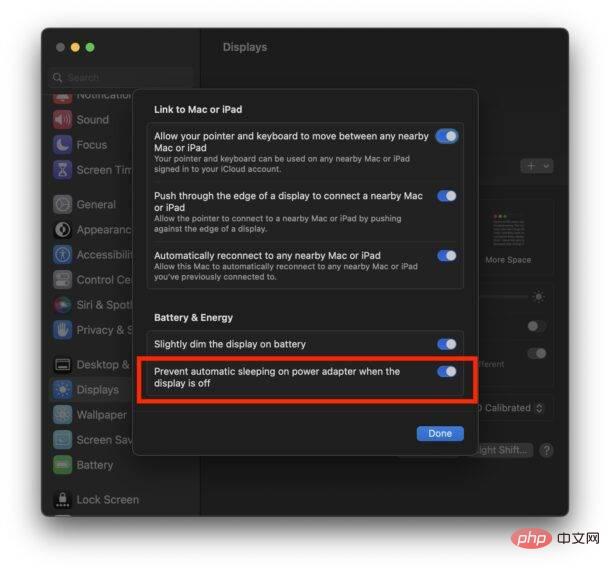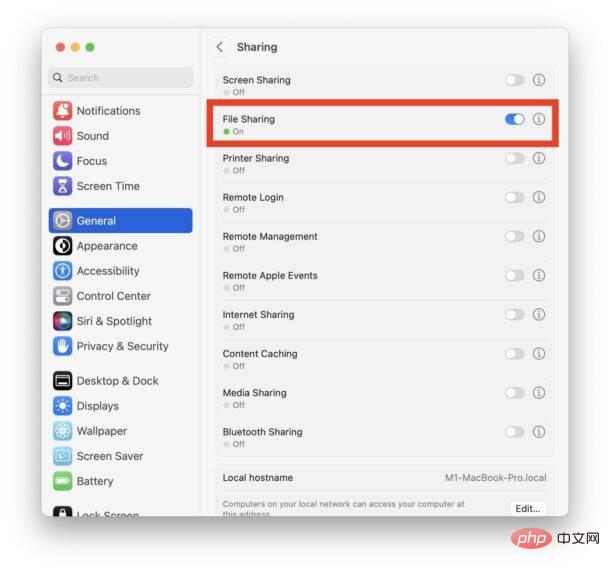 System Tutorial
System Tutorial MAC
MAC Mac cannot automatically move files to USB drive (Mac cannot move files to USB drive)
Mac cannot automatically move files to USB drive (Mac cannot move files to USB drive)php Editor Youzi learned that many Mac users have encountered a problem when using it: they cannot automatically move files to a USB flash drive. This brings inconvenience to users, especially when they need to frequently move files from Mac computers to USB flash drives. Although the Mac system is very convenient in many aspects, it is slightly lacking in this issue. So, why can’t Mac automatically move files to a USB drive? Next, let’s explore the causes of this problem and possible solutions.
Solution to the problem that the mac system cannot copy files to the hard disk U disk
First, insert the hard disk or U disk into the computer. Then, press the [Space] shortcut key, as shown in the figure below. Then, open the [Disk Utility] window and select the disk according to the actual situation, as shown in the figure below.
Follow the wizard prompts and restart the Mac computer to complete the configuration. Find the software icon in Mac "Preferences" and double-click to open it.
Due to the limitations of the disk file system format, Mac cannot store files normally. But we can solve this problem by installing third-party software. First, install a reading and writing tool called "Paragon NTFS for Mac" on your Mac. You can download this software directly from the official website. The installation process is very simple, just double-click the NTFS for Mac software installation package to start the installation.
Solving this problem is simple, just convert the FAT32 format to ExFAT. Requires disk utility for MAC system.
Mac cannot copy and write files to the mobile hard disk, what should I do with the USB flash drive? If you encounter this problem, you can first check the cause and then find the corresponding solution: the hard disk file system is not compatible with Mac computers. This is the most common reason why "Mac cannot copy and write files to the external hard drive".
When copying files to NTFS formatted partitions, sometimes you may encounter inoperability. Because the Mac system does not natively support NTFS partitioned storage devices, you can use third-party software to copy files to a hard drive or USB flash drive for easy access and use.

Why can’t Apple computer files be copied to a USB drive?
The hard disk file system is not compatible with Mac computers. This is the most common reason why "Mac cannot copy and write files to the external hard drive". If your hard drive or USB flash drive is an NTFS file system, Mac does not have "write" permissions for NTFS-formatted hard drives, only "read" permissions.
Normally, when Mac cannot read and write the hard drive normally, one of the main reasons is that the hard drive is formatted as NTFS. Solving this problem becomes very simple, just install an NTFS for Mac software on your Mac. You can download the genuine NTFS for Mac software and start the installation.
The problem is not the file size, but the format of the USB flash drive. The default format of most USB flash drives is FAT32 when shipped from the factory, but this format does not support storing files larger than 4GB. Therefore, when you try to copy large files such as high-definition movies and games, the above prompt will appear.
Nowadays, more and more people are using Mac computers. Some users have encountered the problem of being unable to copy files to disk/U disk and want to know how to solve it. Next, the editor will introduce to you the specific steps. .
Analysis of reasons why the U disk cannot be detected 1) The U disk is not completely inserted into the computer. The U disk is not inserted into the computer properly, so it cannot be opened, and naturally the files cannot be copied.
Mac cannot copy and write files to the mobile hard disk, what should I do with the USB flash drive?
Follow the wizard prompts and restart the Mac computer to complete the configuration. Find the software icon in Mac "Preferences" and double-click to open it.
Open your Mac laptop and connect the mobile hard drive via USB cable. You can see a hard drive icon appear on the desktop. Right-click the icon. There is no copy option at this time, which means that the mobile hard disk is formatted by default under the Windows system and is read-only under MacOS.
If you want to solve the problem of "How does Mac operate NTFS formatted disks", it is actually very simple. You only need to install an NTFS for Mac reading and writing tool. The hard drive is damaged or the hard drive file system is damaged. If there is some problem with the Mac system, it is very likely that the hard drive will become inoperable even if it is connected to the computer.
Solving this problem is simple, just convert the FAT32 format to ExFAT. Requires disk utility for MAC system.
Insert the mobile hard disk into a Windows computer (an Apple computer with dual systems installed will also work) and open the resource manager. Right-click the mouse to select the target hard disk or USB flash drive and click Format. Set the file system to exFAT.
How can Apple computer files be directly pulled into a USB flash drive?
1. Connect the mobile phone to the USB port of the computer and open iTools (iTunes must be installed in advance to start). Switch to the video panel, click Import-Please select the file, and double-click with the left mouse button to select the video file to be imported. Click OK to complete the video file import operation.
2. Select all directly and drag it to the place where it needs to be stored (select all shortcut key command a); copy and paste (shortcut key command c, command v); use the menu bar to copy and paste. Note: The copied USB disk must be in Mac os log format or ms dos (fat32) format.
3. The specific method is as follows: Click Launchpad-Other_Automator, then click File-New in the status bar in the upper right corner, and then select "Workflow". Click Actions - Resource Library - Files and Folders on the left side of the window, and drag "Get Specified Finder Item" into the empty space on the right.
4. Normally, if the mobile hard disk or U disk Mac supports reading and writing, then you can directly pull the file into the U disk or hard disk by selecting the file.
5. Click on the file, command C (copy), open your USB flash drive, command V (paste). One thing to note is that if the USB drive is formatted as NTFS, the Apple system only supports reading, not writing. USB flash drives in FAT format can be read and written.
How to solve the problem of Mac computer not being able to copy files to disk/U disk
First, insert the hard disk or U disk into the computer. Then, press the [Space] shortcut key, as shown in the figure below. Then, open the [Disk Utility] window and select the disk according to the actual situation, as shown in the figure below.
Follow the wizard prompts and restart the Mac computer to complete the configuration. Find the software icon in Mac "Preferences" and double-click to open it.
Solving this problem is simple, just convert the FAT32 format to ExFAT. Requires disk utility for MAC system.
Conclusion: The above is all the content that this site has compiled for you about Mac’s inability to automatically transfer files to USB disk. Thank you for taking the time to read the content of this site. I hope it will be helpful to you. More related content is available here. Forgot to search on this site.
The above is the detailed content of Mac cannot automatically move files to USB drive (Mac cannot move files to USB drive). For more information, please follow other related articles on the PHP Chinese website!
 ip与mac绑定什么意思Mar 09, 2023 pm 04:44 PM
ip与mac绑定什么意思Mar 09, 2023 pm 04:44 PMip与mac绑定是指将特定的IP地址与特定的MAC地址关联起来,使得只有使用该MAC地址的设备才能够使用该IP地址进行网络通信。ip与mac绑定可以防止被绑定的主机的IP地址不被假冒,前提条件:1、MAC地址是唯一的,并且不可假冒;只能绑定与路由器直接相连的网络上的主机(也就是主机的网关在路由器上)。
 mac版下载是什么意思Mar 06, 2023 am 09:52 AM
mac版下载是什么意思Mar 06, 2023 am 09:52 AMmac版下载的意思是当软件在选择安装时,选择MAC版下载;Windows版和MAC版是两个不同的操作系统,所以大多数软件在选择安装的同时需要选择Windows版还是MAC版。
 mac鼠标滚轮相反怎么办Mar 16, 2023 pm 05:44 PM
mac鼠标滚轮相反怎么办Mar 16, 2023 pm 05:44 PMmac鼠标滚轮相反的解决办法:1、打开mac电脑,点击屏幕的苹果标志,然后选择“系统偏好设置”;2、在“系统偏好设置”窗口中,选择“鼠标”;3、在“鼠标”窗口中,将“滚动方向:自然”前面的勾去掉即可。
 如何防止 Mac 在显示器关闭时进入睡眠状态 (MacOS Ventura)Apr 13, 2023 pm 12:31 PM
如何防止 Mac 在显示器关闭时进入睡眠状态 (MacOS Ventura)Apr 13, 2023 pm 12:31 PM显示器关闭时如何防止 Mac 休眠如果您希望 Mac 显示器能够在整个计算机不进入睡眠状态的情况下关闭,请在此处进行适当的设置调整:下拉 Apple 菜单并转到“系统设置”转到“显示”点击“高级...”切换“防止显示器关闭时电源适配器自动休眠”的开关现在 Mac 显示屏可以关闭,同时防止 Mac 本身进入睡眠状态。这可能主要与 Mac 笔记本电脑用户相关,但即使是那些没有 MacBook 的用户也可能会发现该功能很有用。
 修复文件共享在 MacOS Ventura 中不起作用Apr 13, 2023 am 11:34 AM
修复文件共享在 MacOS Ventura 中不起作用Apr 13, 2023 am 11:34 AM修复 SMB 文件共享在 MacOS Ventura 中不起作用的问题从 Apple 菜单打开 Mac 上的“系统设置”应用程序转到“常规”,然后转到“共享”找到“文件共享”的开关并将其关闭通过转到 Apple 菜单并选择重新启动来重新启动 Mac重新启动后,返回共享系统设置面板并将“文件共享”重新设置为打开位置像往常一样恢复文件共享,它应该按预期工作如果 MacOS Ventura Mac 与另一台 Mac 或设备之间的文件共享突然再次停止工作,您可能需要在几天后或随机重复此过程。
 mac的shift键是哪个键Mar 13, 2023 pm 02:20 PM
mac的shift键是哪个键Mar 13, 2023 pm 02:20 PMmac的shift键是fn键上方、caps lock键下方的一个键,该键在键盘最左侧,由右下往上数第2个键;shift键是键盘中的上档转换键,可以通过“Ctrl+Shift”组合键来切换输入法。
 mac解压rar用什么软件Mar 03, 2023 pm 04:18 PM
mac解压rar用什么软件Mar 03, 2023 pm 04:18 PMmac解压rar的软件:1、The Unarchiver,是一款完全免费、小巧,而且非常易于使用的压缩、解压缩小工具;2、Keka,是一款免费、实用的压缩、解压缩工具,支持解压缩RAR格式的压缩包;3、360压缩大师,是一款免费的压缩、解压缩软件,完全支持RAR文件解压;4、MacZip,支持包括RAR在内的超过20种压缩格式的解压;5、BetterZip;6、FastZip。
 mac克隆是什么意思Jan 31, 2023 am 10:33 AM
mac克隆是什么意思Jan 31, 2023 am 10:33 AMmac克隆全称mac地址克隆,是固化在网卡上串行EEPROM中的物理地址,通常有48位长。mac克隆一般应用在路由器上,用户在用电脑直接拨号上网,后来又加了个路由器,通过路由器来实现多台电脑同时上网,这时要用到mac地址克隆了,就是把当前的电脑的mac地址克隆到路由器中去,因为运营商是把你的电脑mac地址绑定你的账号的,所以得克隆以后才能用。


Hot AI Tools

Undresser.AI Undress
AI-powered app for creating realistic nude photos

AI Clothes Remover
Online AI tool for removing clothes from photos.

Undress AI Tool
Undress images for free

Clothoff.io
AI clothes remover

AI Hentai Generator
Generate AI Hentai for free.

Hot Article

Hot Tools

ZendStudio 13.5.1 Mac
Powerful PHP integrated development environment

MinGW - Minimalist GNU for Windows
This project is in the process of being migrated to osdn.net/projects/mingw, you can continue to follow us there. MinGW: A native Windows port of the GNU Compiler Collection (GCC), freely distributable import libraries and header files for building native Windows applications; includes extensions to the MSVC runtime to support C99 functionality. All MinGW software can run on 64-bit Windows platforms.

Notepad++7.3.1
Easy-to-use and free code editor

VSCode Windows 64-bit Download
A free and powerful IDE editor launched by Microsoft

SAP NetWeaver Server Adapter for Eclipse
Integrate Eclipse with SAP NetWeaver application server.





